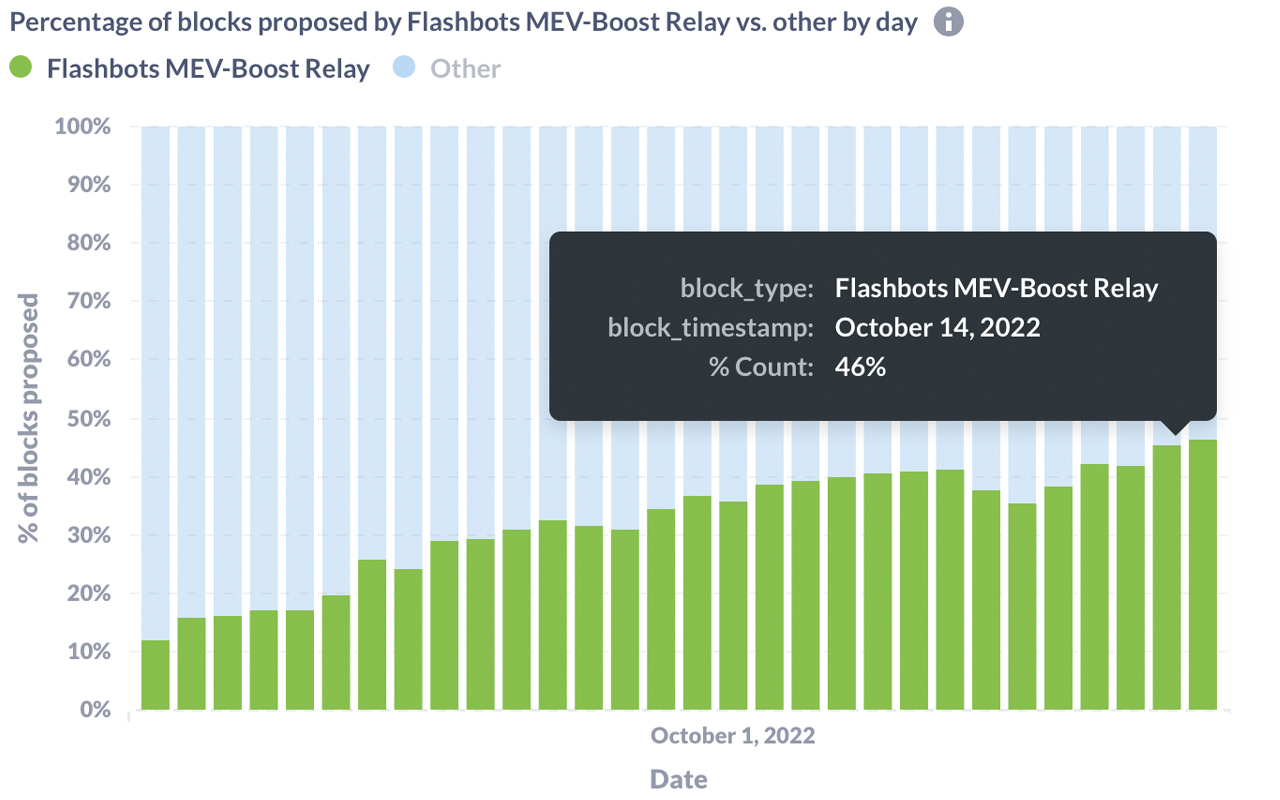For a couple of years now, MEV-Boost relays or Flashbots have become popular tools for gathering the maximum value that can be extracted from Ethereum’s block production. However, in recent times Flashbots have been controversial as people believe the technology threatens Ethereum’s censorship resistance. This is because Flashbots account for 48% of blocks that comply with government-enforced regulations.
Nakamoto coefficient or government coefficient? – Crypto users complain that OFAC-compliant Flashbots have stained Ethereum’s censorship resistance
While Ethereum has been praised for meeting the demands of environmentalists, critics believe that the blockchain network made a trade-off by increasing validator centralization, and the likelihood of increasing censorship for a so-called “greener” blockchain. The day after The Merge, when Ethereum transitioned from a proof-of-work (PoW) network to a proof-of-stake (PoS) blockchain, PoW supporters criticized Ethereum over the increased possibility of validator censorship. Data had shown that more than 59% of all staked ethereum (ETH) was held by four companies.
Although, some people dismissed the critics, such as Bitcoin supporter and blogger Eric Wall, who told his Twitter followers that the floating betting company’s “Lido isn’t even a pool.” Wall further noted that “Lido cannot determine what blocks any of their underlying mine node operators.” Following the topic of increasing validator centralization, another discussion about the use of Flashbots or MEV-Boost relays has risen. Flashbots emerged in November 2020, and researchers from Bitmex describe what MEV-Boost relay technology does in a Flashbots report published last May.
“Flashbots work as follows – Applicants analyze the blockchain and memory pool for MEV opportunities,” explains the Bitmex report on Flashbots. “When they find such an opportunity, they create a transaction or bundle of transactions that takes advantage of it. They then send these transactions to the centralized Flashbots server. These transactions also include a payment for the miners. The idea here is that an applicant will no longer want to bother broadcasting their MEV transactions to the memory pool anymore and will only use the Flashbots system.
Close to half of Ethereum’s daily blocks are OFAC-compliant blocks
The conversation about Flashbots is not really about the technology to find the maximum value that can be extracted from Ethereum’s block production, as the discussion has been based solely on transaction censorship derived from MEV-Boost relays. For example, after the US Treasury watchdog Office of Foreign Asset Control (OFAC) banned Tornado Cash and several ethereum addresses, crypto supporters believe that Flashbots will censor ethereum transactions. That’s because some MEV-Boost relays or Flashbots are centralized and are regulated under OFAC rules.

At the time of writing, 48% of block production has been enforced by OFAC-complaint MEV-Boost relays, according to mevwatch.info statistics. Calculations from flashbots.net’s transparency page show that 46% of blocks on October 14 were OFAC compliant.

Martin Köppelmann, the co-founder of Gnosis, tweeted about the issue when OFAC-compliant block production was above 51%. “We reached another sad milestone in censorship: 51%,” Köppelmann wrote. “This means that if the censorship validators now stop attesting to non-censoring blocks, they will eventually form the canonical 100% censorship chain.”
The Gnosis co-founder added:
Dear Flashbots Team – I spoke to many of you personally and you committed to taking action if censorship worsens – but if not now, when?
The Flashbots team vows to fight censorship, introducing a new tool called SUAVE
According to the Flashbots team and product manager Robert Miller, Flashbots is working on a solution to address censorship issues with a tool called SUAVES. The SUAVE tool is set to be released next week, according to insiders. Furthermore, Flashbot co-founder Stephane Gosselin left the project due to disagreements regarding the ethics of censorship. Speaking exclusively to theblock.co’s contributor Jeremy Nation, Gosselin told the reporter that censorship resistance is very important.
“In the short term, I hope that validators will avoid connecting to relays that perform censorship,” Gosselin told the publication in a direct message on Twitter. “Blockspace vendors putting financial pressure against censorship will go a long way to ensure it doesn’t become ubiquitous,” Flashbot’s co-founder added. At Devcon VI, the Flashbots team introduced the new SUAVE tool to the audience, further explaining that the project is 100% anti-censorship.
“[Phil Daian] states that he is 100% against censorship and even though flashbots are censoring today they want to fight censorship and the way to do that is through [open source]research and open data,” Twitter user Lefteris Karapetsas wrote during Daian’s Devcon VI presentation.
Tags in this story
bitmex research, Blockchain network, censorship of transactions, censorship, controversy, Devcon VI, Devcon VI discussions, ether, Ethereum, Ethereum (ETH), Flashbots, Flashbots censorship, Flashbots controversy, Gnosis co-founder, Lefteris Karapetsas, Martin- Köppelmann , MEV Boost Relays , OFAC Rules , OFAC Compliant , OFAC Compliant Blocking , Office of Foreign Asset Control , Phil Daian , Sanctions , Stephane Gosselin , SUAVE , Technology , Treasury Department Watchdog , US Sanctions
What do you think about the controversy surrounding the MEV-Boost relays or the Flashbots technology? Let us know what you think about this topic in the comments section below.
Jamie Redman
Jamie Redman is the news editor at Bitcoin.com News and a financial technology journalist living in Florida. Redman has been an active member of the cryptocurrency community since 2011. He has a passion for Bitcoin, open source and decentralized applications. Since September 2015, Redman has written more than 6,000 articles for Bitcoin.com News about the disruptive protocols emerging today.
Image credit: Shutterstock, Pixabay, Wiki Commons
Disclaimer: This article is for informational purposes only. It is not a direct offer or solicitation of an offer to buy or sell, or an endorsement or recommendation of products, services or companies. Bitcoin.com does not provide investment, tax, legal or accounting advice. Neither the company nor the author is directly or indirectly responsible for damages or losses caused or alleged to be caused by or in connection with the use of or reliance on content, goods or services mentioned in this article.




























